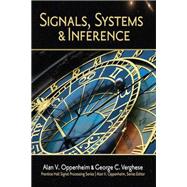An Integrative Approach to Signals, Systems and Inference
Signals, Systems and Inference is a comprehensive text that builds on introductory courses in time- and frequency-domain analysis of signals and systems, and in probability. Directed primarily to upper-level undergraduates and beginning graduate students in engineering and applied science branches, this new textbook pioneers a novel course of study. Instead of the usual leap from broad introductory subjects to highly specialized advanced subjects, this engaging and inclusive text creates a study track for a transitional course. Properties and representations of deterministic signals and systems are reviewed and elaborated on, including group delay and the structure and behavior of state-space models.
The text also introduces and interprets correlation functions and power spectral densities for describing and processing random signals. Application contexts include pulse amplitude modulation, observer-based feedback control, optimum linear filters for minimum mean-square-error estimation, and matched filtering for signal detection. Model-based approaches to inference are emphasized, in particular for state estimation, signal estimation, and signal detection. The text explores ideas, methods and tools common to numerous fields involving signals, systems and inference: signal processing, control, communication, time-series analysis, financial engineering, biomedicine, and many others. Signals, Systems, and Inference is a long-awaited and flexible text that can be used for a rigorous course in a broad range of engineering and applied science curricula.








